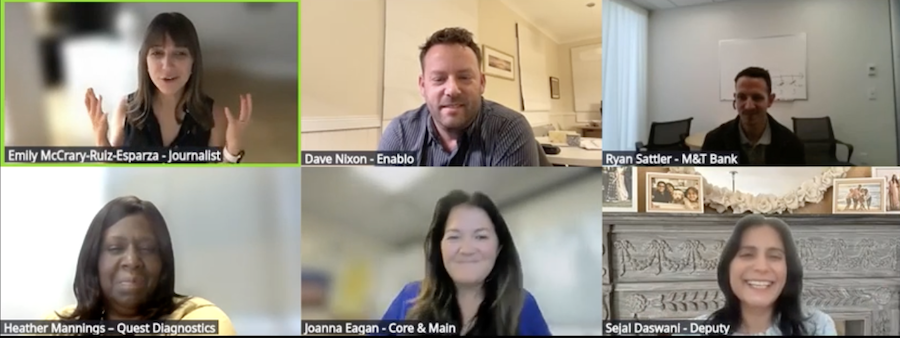Optimizing Productivity and Efficiency in Times of Constraint


As companies face tighter budgets, leaner teams, and pressure to boost productivity, one thing has become clear: Success depends less on scale and more on resourcefulness. The winners aren’t necessarily those with the biggest teams or deepest pockets—but those that can make the most of what they have.
That was the takeaway from an executive panel discussion at From Day One’s September virtual conference. Panelists shared how they’re tackling the modern dilemma of how to stay effective when everyone is stretched thin.
Balancing Priorities and Capacity
“One of the biggest disconnects between leadership’s expectations and employees’ day-to-day is capacity versus priority,” said Joanna Eagan, senior director of people services at Core & Main. “Leaders tend to set ambitious productivity goals with the best intentions, but employees are juggling competing demands, a lot of administrative tasks, and often outdated tools. It can feel like leadership is asking for more without taking anything off their plates.”
Ryan Sattler, director of HR tech and intelligence at M&T Bank, agreed that clarity is often a problem. “I don’t think many organizations do a particularly good job at clarifying and articulating where employees should be spending their energy,” he said. It’s easy to keep doing the same things, even when leadership has set new priorities. Leaders, Sattler added, should focus on strategy, removing obstacles and setting direction, rather than dictating day-to-day work.
Managing Change From the Inside Out
When every quarter seems to bring a new system, workflow, or AI automation, change fatigue becomes a real problem. By the time new initiatives reach the frontline, those workers often haven’t been part of the conversation. “We need to focus on listening to our employees and their experiences, reprioritizing low-value work so they can get on board with the pivots being asked of them,” said Eagan.
To help new tools catch on, HR tech platform Deputy designates “AI Champions”—enthusiastic early adopters who can model success for their peers. “Instead of having something come from the top down, we’re building excitement and momentum from the middle of the organization and from the bottom up,” said Sejal Daswani, Deputy’s chief people officer.

“Change is difficult for everyone, even if we know it’s going to make our life easier,” added Heather Mannings, executive director and HR business partner at Quest Diagnostics. Her team makes changes with a lot of explanation, and welcomes input from employees on how to make it better—after all, they’re the ones using it.
Simplifying Work Through Smart Automation
Core & Main began its automation journey by targeting tedious, error-prone parts of payroll, and ultimately gaining hundreds of hours in productivity. Deputy reports similar benefits: Internal surveys found that AI tools are saving employees five to ten hours per week in writing, messaging, and presentation work.
As tools multiply, integration remains a challenge. “I haven’t met a customer or frontline employee yet who says they don’t have enough apps, tools, or systems,” said Dave Nixon, CEO and co-founder of Enablo, an all-in-one communications platform for frontline workforces. The problem is integration. Companies are aspiring to reduce complexity for frontline workers—a single “digital front door” where they can check shifts, report incidents, and get company updates.
The next era of productivity isn’t about squeezing more hours out of employees, it’s about removing friction, clarifying priorities, and designing systems that let people focus on work that matters. Whether through automation, better communication, or smarter change management, organizations are finding that efficiency in 2025 doesn’t come from doing more—it comes from doing less, better.
Emily McCrary-Ruiz-Esparza is an independent journalist and From Day One contributing editor who writes about business and the world of work. Her work has appeared in the Economist, the BBC, The Washington Post, Inc., and Business Insider, among others. She is the recipient of a Virginia Press Association award for business and financial journalism. She is the host of How to Be Anything, the podcast about people with unusual jobs.
(Photo by miniseries/iStock)
The From Day One Newsletter is a monthly roundup of articles, features, and editorials on innovative ways for companies to forge stronger relationships with their employees, customers, and communities.